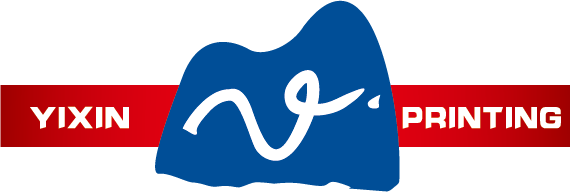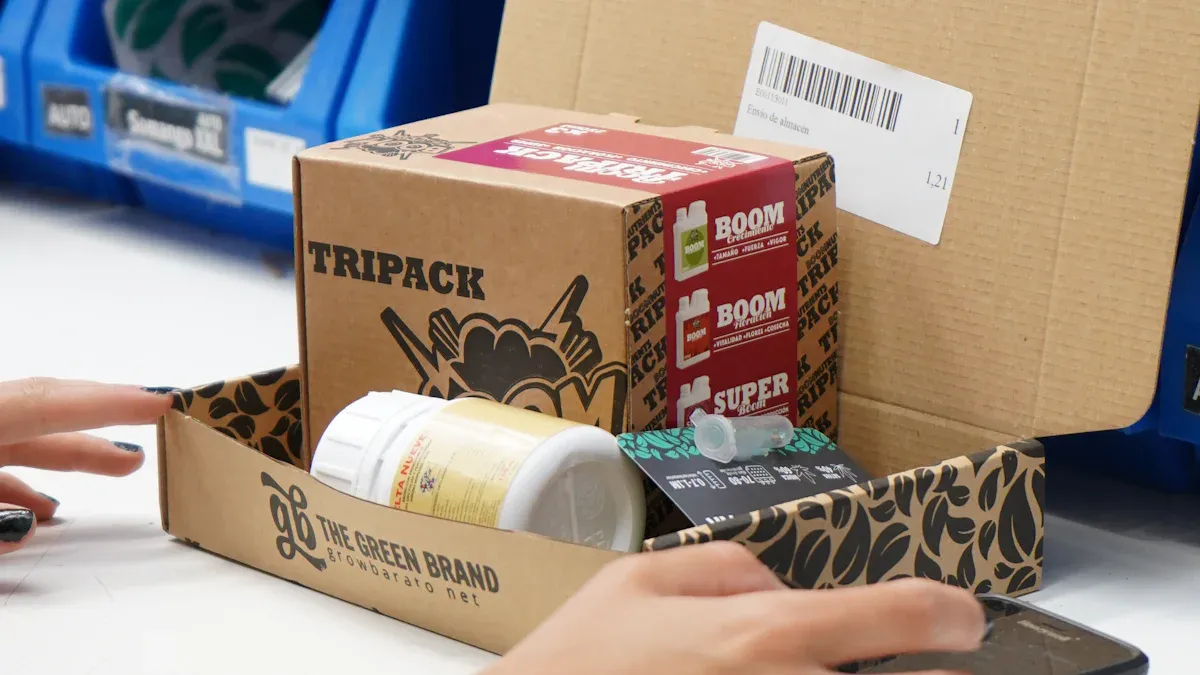The e-commerce boom has revolutionized the packaging industry, driving a significant demand for innovative solutions. With the e-commerce packaging market valued at USD 49.5 billion in 2023 and projected to reach USD 97.3 billion by 2032 at a CAGR of 8.0%, the need for custom made paper boxes and luxury paper boxes has never been greater. These packaging options provide both sustainability and exceptional branding opportunities. YiXin Printing excels in offering cutting-edge designs tailored to meet these dynamic market demands.
Key Takeaways
Online shopping packaging is changing fast, with the market expected to hit $97.3 billion by 2032. Companies need to change their packaging to match what customers want and to be more eco-friendly.
Specially designed paper boxes keep items safe and make opening packages more fun. This helps make customers happy and loyal to the brand. Spending on custom packaging can make a brand more attractive.
Being eco-friendly matters a lot to shoppers, with 66% choosing green options. Businesses should use materials that can be recycled or break down naturally to match customer values and help the planet.
E-commerce Growth and Packaging Demands
Impact of the e-commerce boom on packaging
The rapid growth of e-commerce has transformed the way businesses approach packaging. With online sales increasing, companies must ensure their packaging meets the demands of automated handling, long-distance shipping, and consumer expectations. For instance, the e-commerce packaging market grew from $16.8 billion in 2022 to a projected $21.4 billion in 2024. This surge highlights the need for innovative designs that balance durability and efficiency.
Packaging innovations have become essential, especially in sectors like e-grocery. Square and rectangular designs now dominate due to their ability to maximize space during shipping. Improved sealing systems and informative labels also play a critical role in ensuring product safety and enhancing the customer experience. Over 86% of brand managers have adjusted their packaging strategies to cater to online sales, emphasizing the importance of adapting to this evolving market.
Challenges in meeting e-commerce demands
Meeting e-commerce demands presents unique challenges. Environmental concerns top the list, as consumers increasingly prefer sustainable options. For example, 66% of buyers now prioritize eco-friendly products. However, managing packaging waste remains complex, especially with the rise in disposable materials like poly mailers and bubble wrap.
The COVID-19 pandemic further intensified these challenges. E-commerce companies experienced a surge in orders, leading to increased waste and environmental degradation. Most consumers discard non-reusable packaging, adding to the problem. Balancing sustainability with functionality has become a critical focus for businesses.
Role of custom made paper boxes in online retail
Custom made paper boxes have emerged as a game-changer in online retail. These boxes not only protect products but also enhance the unboxing experience, a key factor in customer satisfaction. The market for custom electronic goods packaging, valued at $5 billion in 2022, is expected to grow at a 6% CAGR over the next five years. This growth reflects the rising demand for tailored solutions that align with brand identity and consumer preferences.
Sustainability also drives the popularity of custom paper boxes. With recycling rates for paper and cardboard reaching 88% in 2021, these materials offer an eco-friendly alternative to plastic. By investing in custom packaging, businesses can meet e-commerce demands while reducing their environmental footprint.
Sustainability and Eco-Friendly Materials
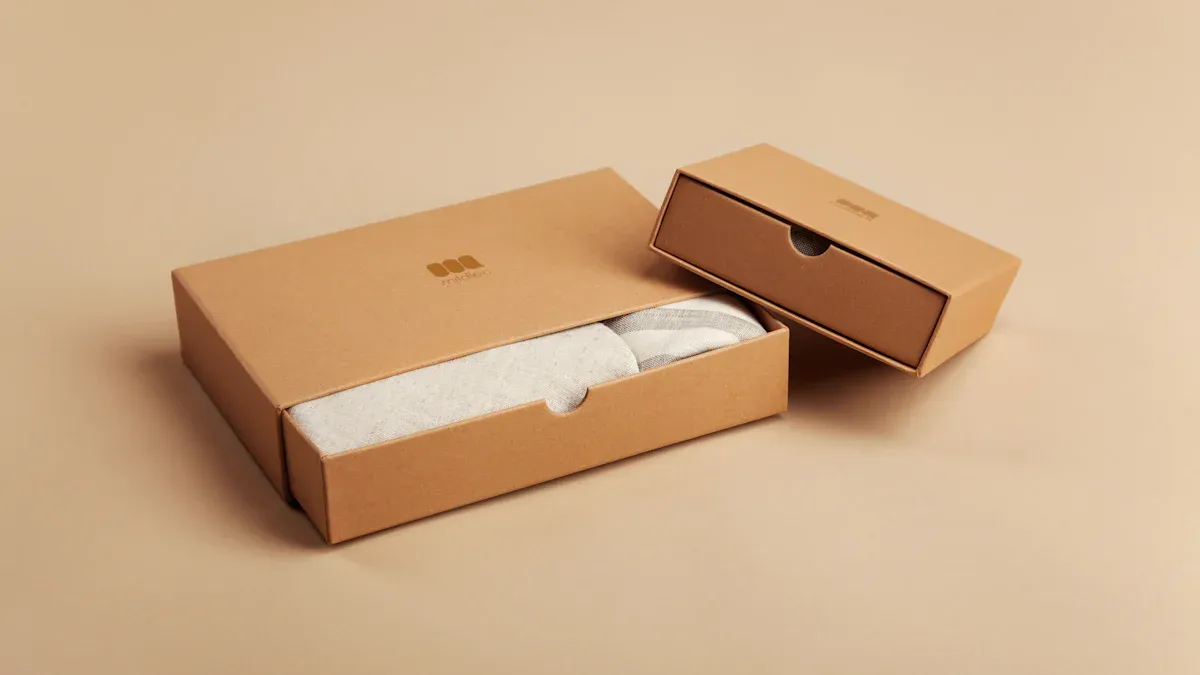
Rise of recyclable and biodegradable materials
I’ve noticed a growing shift toward recyclable and biodegradable materials in packaging designs. This change stems from increasing consumer awareness about sustainability. Many people now prefer products that align with eco-friendly values. For example, 78% of U.S. consumers check recycling information on labels, and nearly half avoid excessive packaging. These trends highlight the importance of using sustainable materials in packaging.
The sustainable packaging market is also expanding rapidly. It’s projected to reach $423.56 billion by 2029. Products with ESG (Environmental, Social, and Governance) claims have grown by 28% over five years, compared to 20% for those without such claims. This data shows how sustainability drives both consumer behavior and industry growth.
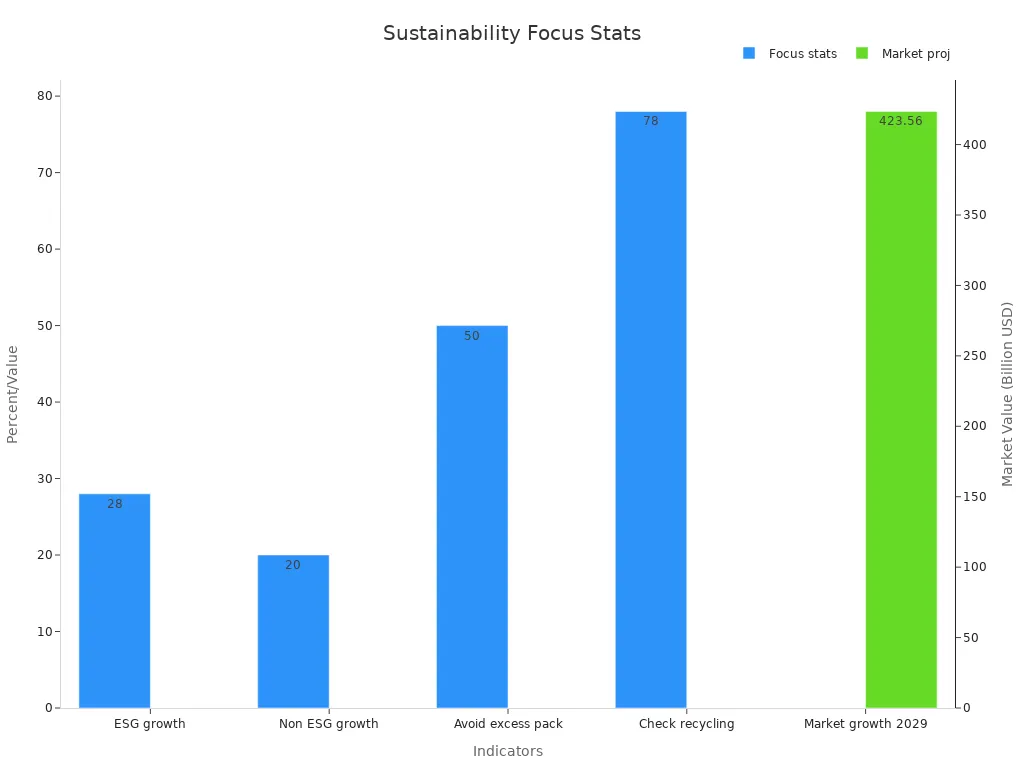
Minimalistic designs for reduced waste
Minimalistic packaging designs have become a game-changer in reducing waste. I’ve seen companies simplify their packaging by using fewer materials and eliminating unnecessary features. This approach not only reduces waste but also cuts costs. For instance, brands like Apple have reduced box sizes and eliminated excess space, making their packaging more efficient.
Many businesses now focus on essential components in their designs. They avoid unnecessary layers of plastic and opt for streamlined solutions that maintain product protection. This strategy aligns perfectly with the principles of sustainability, as it minimizes environmental impact while meeting functional needs.
YiXin Printing’s eco-friendly packaging solutions
At YiXin Printing, we prioritize sustainability in our packaging designs. We use recyclable and biodegradable materials to create custom-made paper boxes that meet modern eco-friendly standards. Our team also embraces minimalistic designs to reduce waste and enhance shipping efficiency. By combining innovative techniques with sustainable materials, we help businesses achieve their environmental goals while delivering high-quality packaging solutions.
Innovations in Design and Technology
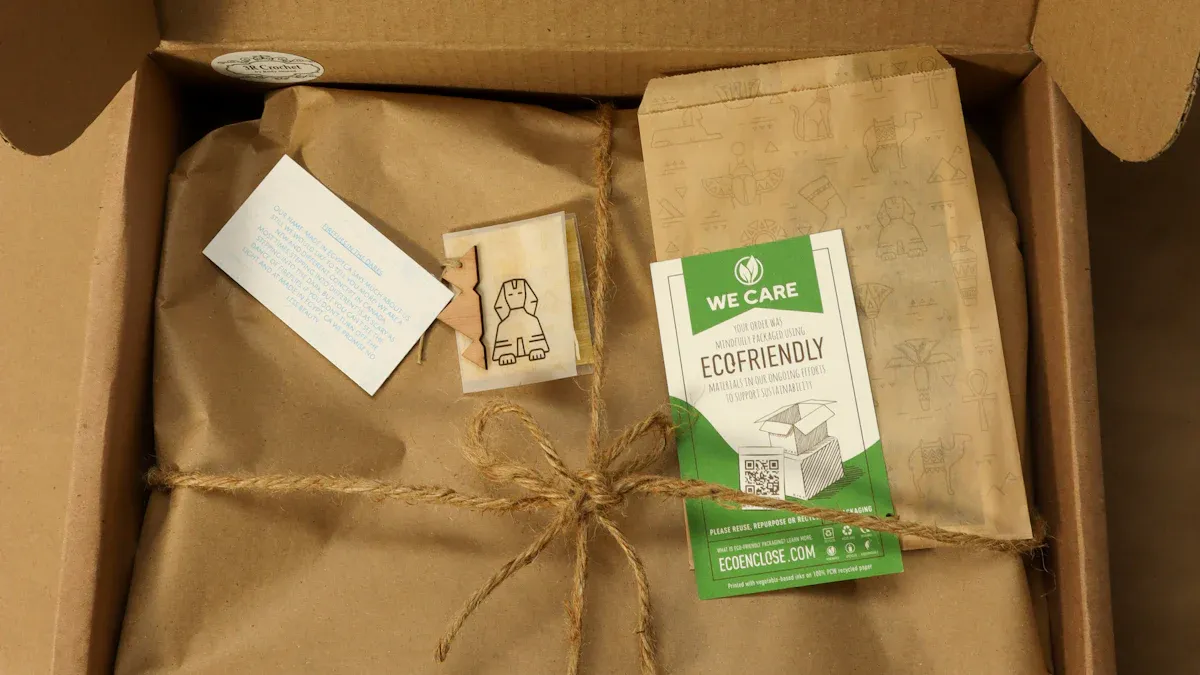
Smart packaging for the e-commerce market
Smart packaging has transformed how businesses interact with customers. I’ve noticed how it enhances user experience by integrating technology into packaging design. For example, Marks and Spencer (M&S) use QR codes on their toilet packaging to share health information, while PepsiCo’s campaigns engage customers with competitions and music through similar codes. These features make packaging more interactive and memorable.
Smart packaging also addresses critical issues like product spoilage and counterfeit goods. Food retailers estimate that 31% of food products are discarded due to spoilage, costing billions annually. By incorporating sensors or indicators, smart packaging can monitor freshness and reduce waste. It also combats counterfeit goods, which cause significant financial losses. These innovations not only improve customer satisfaction but also strengthen brand loyalty.
Automation in creating custom made paper boxes
Automation has revolutionized the production of custom made paper boxes. I’ve seen how AI systems optimize box sizes, reducing material waste by 40% and cutting shipping costs by 25%. This technology ensures that packaging design meets the exact needs of each product, enhancing efficiency and customer satisfaction.
Mass customization is another benefit of automation. Businesses can quickly adapt packaging designs for different markets without compromising production speed. This flexibility allows companies to stay competitive in the fast-paced e-commerce industry. Automation also reduces labor costs, making it a cost-effective solution for large-scale packaging production.
Lightweight designs for shipping efficiency
Lightweight packaging designs play a crucial role in reducing shipping costs. I’ve observed how companies use materials like cardboard to create sturdy yet lightweight packaging. This approach minimizes shipping expenses while maintaining product protection. Cubic pricing, which charges based on volume rather than weight, further highlights the importance of lightweight designs.
Optimizing packaging size also improves efficiency. Oversized boxes waste space and materials, while undersized ones risk product damage. Modular packaging designs solve this problem by adapting to various product sizes. These innovations streamline operations and reduce costs, making lightweight packaging a smart choice for e-commerce businesses.
Consumer Experience and Branding
Unboxing trends in luxury paper boxes
I’ve noticed how unboxing has become a vital part of the customer experience in e-commerce. Luxury paper boxes play a significant role in creating memorable unboxing experiences. A study by Pregis and the University of Wisconsin revealed that premium packaging materials can elevate the perceived value of a product by 45%. Customers associate high-quality packaging with superior product quality. This emotional connection enhances consumer satisfaction and builds brand loyalty.
Luxury paper boxes often feature intricate designs, soft-touch finishes, and eco-friendly materials. These elements not only improve the unboxing experience but also align with sustainable practices. Many brands now use sustainable packaging solutions to meet consumer expectations while reducing their environmental impact. I’ve seen how this approach resonates with customers who value both aesthetics and sustainability.
Personalization in e-commerce packaging
Personalization has transformed how brands connect with their customers. Custom made paper boxes allow businesses to tailor packaging to individual preferences, creating a unique customer experience. For example, Coca-Cola’s personalized bottle campaign boosted consumer engagement and sales. Similarly, Nutella’s customized jars enhanced brand loyalty and satisfaction. These examples show how personalization can make packaging more appealing and memorable.
I believe personalized packaging also strengthens emotional bonds between brands and consumers. Adding names, messages, or unique designs to packaging makes customers feel valued. This strategy not only increases consumer satisfaction but also encourages repeat purchases. Personalization, combined with sustainable practices, creates a powerful tool for enhancing brand appeal.
Enhancing brand identity with YiXin Printing
At YiXin Printing, I’ve seen how we help businesses elevate their brand identity through innovative packaging solutions. Our custom made paper boxes and luxury paper boxes combine functionality with aesthetics. We focus on creating designs that reflect a brand’s values and resonate with its target audience. By incorporating sustainable packaging solutions, we ensure that our products meet modern eco-conscious standards.
Our team also prioritizes the unboxing experience. We use premium materials and creative designs to leave a lasting impression on customers. This approach not only boosts consumer satisfaction but also strengthens brand loyalty. With YiXin Printing, businesses can achieve a perfect balance between sustainability, functionality, and branding.
Logistics and Shipping Efficiency
Modular designs for optimized shipping
Modular packaging designs have revolutionized shipping by simplifying logistics and reducing costs. I’ve seen how these designs use standardized components to streamline transportation and minimize administrative complexities. For example, modularization allows businesses to optimize load arrangements, reducing the need for re-securing during transit. This approach enhances efficiency across various transportation modes.
A closer look at logistics data highlights the benefits of modular designs. They improve air circulation in shipping containers, reducing the risk of mold and mildew. They also simplify the handling of heavy items, preventing them from shifting during transport. These features ensure products remain intact, even during rough handling. By addressing these challenges, modular packaging solutions help businesses achieve greater shipping efficiency.
Cost-effective solutions with lightweight materials
Lightweight packaging solutions offer significant cost savings while maintaining product protection. Brands using lightweight materials have reported a 12-18% reduction in material costs. Additionally, optimized dimensional weight has led to a 15% decrease in transit costs. These savings highlight the financial benefits of adopting lightweight designs.
I’ve noticed how businesses use data analysis to identify cost-saving opportunities. Annual packaging audits often reveal areas for improvement, such as reducing raw material usage. As bio-based materials become more prevalent, companies can expect a further 10% drop in raw material costs. Lightweight packaging not only reduces expenses but also enhances shipping efficiency by minimizing overall weight.
Balancing durability and efficiency in packaging
Striking the right balance between durability and efficiency is crucial for effective packaging solutions. I’ve observed how businesses achieve this by optimizing box sizes and using sturdy materials. For instance, a retailer saved over $10,000 in one year by switching to smaller boxes. This change reduced shipping costs and improved transport efficiency.
IKEA’s flat-pack designs provide another excellent example. By reducing box sizes, IKEA maximizes transport efficiency and aligns with sustainability goals. Similarly, a logistics company improved efficiency by rearranging its warehouse layout, cutting shipping costs by 20% and decreasing product damage. These examples show how durable yet efficient packaging can drive cost savings and enhance operational performance.
Future Trends and Challenges
Circular packaging systems in the e-commerce market
I’ve observed how circular packaging systems are transforming the e-commerce market. These systems focus on reusing materials and reducing waste. By using recycled content, businesses can lower their dependency on virgin resources, which often reduces costs. Reusable packaging designs also help companies save money by minimizing the need for frequent purchases. Lightweight circular packaging further cuts transportation expenses by reducing shipping weights.
To implement circular systems, businesses can follow three key steps. First, they should select recyclable or biodegradable materials to promote sustainability. Second, modular designs can make packaging easier to disassemble, improving material recovery. Finally, extended producer responsibility (EPR) programs ensure companies remain accountable for their packaging throughout its lifecycle. These strategies not only benefit the environment but also enhance operational efficiency.
Adapting to environmental regulations
Environmental regulations are reshaping the e-commerce market. Governments now encourage businesses to adopt biodegradable and compostable packaging. For example, the U.S. Environmental Protection Agency (EPA) promotes waste reduction through initiatives like the Sustainable Materials Management Program. Many states have also introduced laws, such as bans on single-use plastic bags, to address environmental concerns.
I’ve noticed how these regulations push companies to innovate. Many brands now use renewable and low-carbon materials instead of fossil fuel-derived plastics. This shift aligns with consumer preferences for eco-friendly products. By staying ahead of these regulations, businesses can meet customer expectations while avoiding penalties.
Innovations shaping the future of luxury paper boxes
Luxury paper boxes are evolving to meet the demands of the e-commerce market. Brands are adopting sustainable materials, such as recycled ocean plastics and bio-materials, to appeal to eco-conscious consumers. The corrugated look is gaining popularity, offering a balance between elegance and sustainability. Packaging is also becoming a storytelling medium, allowing brands to connect with customers on a deeper level.
High-end packaging now enhances the unboxing experience for online shoppers. I’ve seen how intricate designs and premium finishes elevate the perceived value of products. This trend reflects the growing importance of packaging in creating memorable customer experiences. As social media continues to influence consumer behavior, personalized and visually appealing packaging will remain a key focus for brands.
The e-commerce packaging market continues to evolve, driven by the need for sustainability, innovation, and efficiency. Businesses now prioritize eco-friendly materials, streamlined designs, and enhanced consumer experiences to meet growing demands. For example:
The sustainable e-commerce packaging market was valued at $32.9 billion in 2018 and is projected to reach $63.3 billion within five years. This growth reflects the rising demand for environmentally friendly solutions. At YiXin Printing, we lead the way by offering custom made paper boxes and luxury paper boxes that align with these trends. Our designs enhance brand identity while addressing environmental concerns.
The evolution of packaging now considers the entire lifecycle, from raw material sourcing to recyclability. As the e-commerce packaging market expands, businesses must continue innovating to balance operational efficiency with sustainability. YiXin Printing remains committed to delivering solutions that meet these challenges, ensuring businesses thrive in this dynamic market.
FAQ
What makes custom paper boxes ideal for online purchases?
Custom paper boxes protect products during transit and enhance the unboxing experience. They also allow businesses to align packaging with their brand identity and values.
How do paper box designs support environmental sustainability?
Paper box designs use recyclable and biodegradable materials, reducing waste. This approach minimizes the environmental impact while meeting consumer demand for eco-friendly packaging solutions.
Why is the unboxing experience important in e-commerce?
The unboxing experience creates a lasting impression on customers. It boosts satisfaction, strengthens brand loyalty, and encourages repeat online purchases, making it a key focus for businesses.
